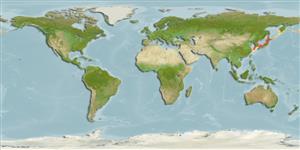Environment: milieu / climate zone / depth range / distribution range
ນິເວດວິທະຍາ
ສັດທະເລ ອາໄສຢູ່ໃກ້ໜ້າດິນໃຕ້ພື້ນທ້ອງນ້ຳ; ລະດັບຄວາມເລິກ 1 - 300 m (Ref. 51666), usually ? - 70 m (Ref. 51666). Temperate
Northwest Pacific: Japan (Ref. 559) and South Korea (Ref. 77001).
ຂະໜາດ / ນ້ຳໜັກ / Age
Maturity: Lm ? range ? - ? cm
Max length : 15.0 cm SL ຕົວຜູ້/ບໍ່ມີເພດ; (Ref. 559)
Found near shore among algal beds; usually shallower than 70 meters, but found to depth of 300 meters (Ref. 51666).
Life cycle and mating behavior
ການຈະເລີນເຕັມໄວ | ການສືບພັນ | ການວາງໄຂ່ | ໄຂ່ | ຄວາມດົກຂອງໄຂ່ປາ | ຕົວອ່ອນ
Masuda, H., K. Amaoka, C. Araga, T. Uyeno and T. Yoshino, 1984. The fishes of the Japanese Archipelago. Vol. 1. Tokai University Press, Tokyo, Japan. 437 p. (text). (Ref. 559)
IUCN Red List Status (Ref. 130435: Version 2024-1)
Threat to humans
Harmless
Human uses
ເຄື່ອງມື
Special reports
Download XML
ແຫຼ່ງອີນເຕີເນັດ
Estimates based on models
Preferred temperature (Ref.
123201): 3.3 - 15.6, mean 9.7 °C (based on 16 cells).
Phylogenetic diversity index (Ref.
82804): PD
50 = 0.6250 [Uniqueness, from 0.5 = low to 2.0 = high].
Bayesian length-weight: a=0.00389 (0.00180 - 0.00842), b=3.12 (2.94 - 3.30), in cm total length, based on all LWR estimates for this body shape (Ref.
93245).
ຊັ້ນເຂດຮ້ອນ (Ref.
69278): 3.3 ±0.5 se; based on size and trophs of closest relatives
Fishing Vulnerability (Ref.
59153): Low vulnerability (10 of 100).
Nutrients (Ref.
124155): Calcium = 68.4 [35.2, 136.3] mg/100g; Iron = 0.376 [0.214, 0.710] mg/100g; Protein = 17.5 [16.5, 18.5] %; Omega3 = 0.477 [0.244, 0.872] g/100g; Selenium = 13.3 [6.1, 28.7] μg/100g; VitaminA = 29.1 [7.5, 107.5] μg/100g; Zinc = 0.857 [0.587, 1.262] mg/100g (wet weight);
